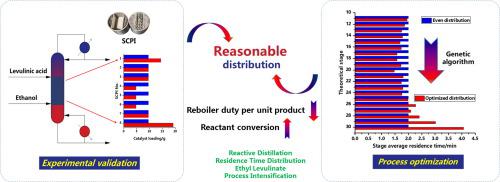Chemical Engineering Science ( IF 4.1 ) Pub Date : 2021-02-25 , DOI: 10.1016/j.ces.2021.116559 Pengfei Yang , Xingang Li , Hong Li , Haifeng Cong , Anton A. Kiss , Xin Gao

|
This work is the first to explore the influence and illustrate the impact of the stage average residence time distribution (SARTD) in the reaction section on the performance of reactive distillation (RD) systems, providing guidance for the design of the internals and industrial applications of RD processes. The experimental validation and process optimization were performed using the ethyl levulinate production as case study. Kinetics of the esterification reaction between levulinic acid (LA) and ethanol was explored using an ion exchange resin as catalyst, and then fitted by a pseudo-homogeneous model, providing basic data for subsequent RD pilot-scale experiment and process simulations. The RD experiment was successfully carried out for two catalyst-loading conditions (uniform or non-uniform per stage) to illustrate the impact of SARDT on the RD performance. The experimental results show that the conversion of LA increases by 10.85% (percentage points) after catalyst loading redistribution. A genetic algorithm (GA) with global convergence and fast convergence speed was used to realize the optimization of SARTD instead of using arbitrary settings. The objective function to be minimized was the reboiler duty per unit product (RDP). The optimization results show that the conversion of LA increases by 3.06% (percentage points) and RDP decreases by 10.09% if the SARTD is optimally redistributed. Based on this, it can be predicted that the total catalyst-loading can be reduced by reasonable catalyst redistribution in the industrial applications of RD. In addition, a new method for optimal design of SARTD is proposed, paving the way for optimizing other RD processes.
中文翻译:

阐明停留时间分布对反应精馏性能的影响–工艺优化和实验验证
这项工作是第一个探索并说明舞台平均停留时间分布的影响的工作(SARTD)中关于反应蒸馏(RD)系统性能的反应部分,为RD工艺的内部和工业应用设计提供指导。实验验证和工艺优化以乙酰丙酸乙酯生产为例进行。使用离子交换树脂作为催化剂探索乙酰丙酸(LA)与乙醇之间的酯化反应动力学,然后通过拟均相模型进行拟合,为随后的RD中试实验和过程模拟提供基础数据。在两种催化剂负载条件下(每阶段均匀或不均匀)成功进行了RD实验,以说明SARDT对RD性能的影响。实验结果表明,LA的转化率提高了10。催化剂负载量重新分配后为85%(百分点)。使用全局收敛和快速收敛速度的遗传算法(GA)来实现SARTD的优化,而不是使用任意设置。要最小化的目标函数是每单位产品的再沸器负荷(RDP)。优化结果表明,如果以最佳方式重新分配SARTD,则LA的转化率提高3.06%(百分点),RDP降低10.09%。基于此,可以预测,通过在RD的工业应用中合理地重新分配催化剂,可以减少总催化剂负载。此外,提出了一种优化SARTD设计的新方法,为优化其他RD工艺铺平了道路。使用全局收敛和快速收敛速度的遗传算法(GA)来实现SARTD的优化,而不是使用任意设置。要最小化的目标函数是每单位产品的再沸器负荷(RDP)。优化结果表明,如果以最佳方式重新分配SARTD,则LA的转化率提高3.06%(百分点),RDP降低10.09%。基于此,可以预测,通过在RD的工业应用中合理地重新分配催化剂,可以减少总催化剂负载。此外,提出了一种优化SARTD设计的新方法,为优化其他RD工艺铺平了道路。使用全局收敛和快速收敛速度的遗传算法(GA)来实现SARTD的优化,而不是使用任意设置。要最小化的目标函数是每单位产品的再沸器负荷(RDP)。优化结果表明,如果以最佳方式重新分配SARTD,则LA的转化率提高3.06%(百分点),RDP降低10.09%。基于此,可以预测,通过在RD的工业应用中合理地重新分配催化剂,可以减少总催化剂负载。此外,提出了一种优化SARTD设计的新方法,为优化其他RD工艺铺平了道路。优化结果表明,如果以最佳方式重新分配SARTD,则LA的转化率提高3.06%(百分点),RDP降低10.09%。基于此,可以预测,通过在RD的工业应用中合理地重新分配催化剂,可以减少总催化剂负载。此外,提出了一种优化SARTD设计的新方法,为优化其他RD工艺铺平了道路。优化结果表明,如果以最佳方式重新分配SARTD,则LA的转化率提高3.06%(百分点),RDP降低10.09%。基于此,可以预测,通过在RD的工业应用中合理地重新分配催化剂,可以减少总催化剂负载。此外,提出了一种优化SARTD设计的新方法,为优化其他RD工艺铺平了道路。











































 京公网安备 11010802027423号
京公网安备 11010802027423号